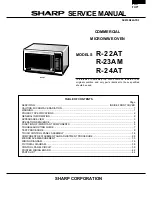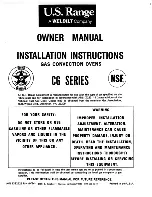
10
R - 2 2 A T
R-23AM
R - 2 4 A T
Room temperature ................................................................................................. T0 = 21
°
C
Initial temperature .................................................................................................. T1 = 11
°
C
Temperature after (28 + 3) = 31 sec [for R-22AT].................................................. T2 = 21
°
C
Temperature after (22 + 3) = 25 sec [for R-23AM/24AT] ....................................... T2 = 21
°
C
Temperature difference Cold-Warm ......................................................................
∆
T1 = 10˚C
Measured output power
The equation is “P = 150 x
∆
T” [for R-22AT] ........................... P = 150 x 10
°
C = 1500 Watts
The equation is “P = 190 x
∆
T” [for R-23AM/24AT] ................ P = 190 x 10
°
C = 1900 Watts
JUDGMENT: The measured output power should be within the range of
±
15 % of the rated output
power.
CAUTION: 1
°
C CORRESPONDS TO 150 WATTS [R-22AT]/ 190 WATTS [R-23AM, R-24AT]. REPEAT
MEASUREMENT IF THE POWER IS INSUFFICIENT.
TEST PROCEDURES
PROCEDURE
LETTER
COMPONENT TEST
1000g
1000g
1000g
T1˚C
T2˚C
Heat up for 31 sec. for R-22AT
Heat up for 25 sec. for R-23AM/ R-24AT
MICROWAVE OUTPUT POWER (2000 cc alternative method)
The power output of this oven is rated using the method specified by IEC 60705. Full details of how
to curry out this procedure can be found in the Sharp Technical Training notes which is available from
Sharp Parts Centre (part number SERV-LITMW01).
The IEC-60705 procedure must be carried out using laboratory-type procedures and equipment.
These requirements make the procedure unsuitable for routine performance checks.
NOTE: The following test method gives an indication of the output power only, it cannot be used to
establish the actual/rated output power. If the true output power is required, then the IEC60705
test method must be used.
Alternative simplified method:
1. Place 2 litres of cold water (between 12
°
C and 20
°
C) in a suitable container.
2. Stir the water and measure the temperature in
°
C. Note temperature as T1.
3. Place the container in the microwave and heat the water for 56 sec. [R-22AT]/ 44 sec. [R-23AM,
R-24AT] on fill power.
4. When the 56 sec. [R-22AT]/ 44 sec. [R-23AM, R-24AT] is completed, remove the container and
stir the water. Note temperature as T2.
5. Calculate the output power using the following formula:
R.F. Power Output = (T2 - T1) x 150 for R-22AT.
R.F. Power Output = (T2 - T1) x 190 for R-23AM, R-24AT.
NOTE: The result from this test should be within the allowance of 2000cc alternative method.
(
±
10%).
MICROWAVE LEAKAGE TEST
This oven should be tested for microwave leakage on completion of any repair or adjustment, following
the procedure described in the Sharp Technical Training notes (part number SERV-LITMW01). The
maximum leakage permitted in BS EN 60335-2-25 is 50W/m
2
(equivalent to 5W/m
2
), however it is not
normal to detect any significant leakage, therefore, any leakage which is detected should be
investigated.
It is essential that only leakage detectors with current calibration traceable to National Physical
Laboratories are used.
Suitable leakage detectors: CELTEC A100
APOLLO X1













































